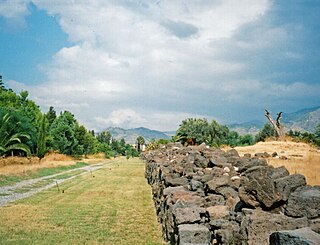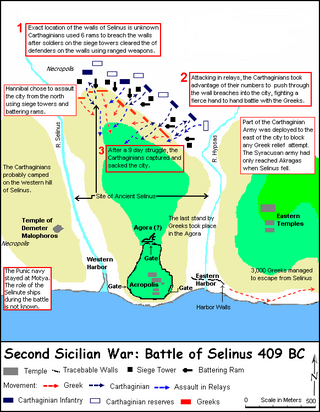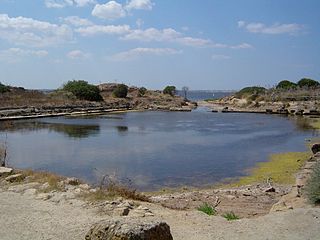
This is a timeline of ancient Greece from its emergence around 800 BC to its subjection to the Roman Empire in 146 BC.
Gelon also known as Gelo, son of Deinomenes, was a Greek tyrant of the Sicilian cities Gela and Syracuse, and first of the Deinomenid rulers.
Heraclides, Heracleides or Herakleides in origin was any individual of the legendary clan of the Heracleidae, the mythological patronymic applying to persons descended from Hercules. As they were of the legendary tribe of the Dorians, the name in the classical age could mean anyone of Dorian background. The Dorians had their own group of dialects, which may or may not have been spoken by given individuals. Usage of the name was concentrated at Syracuse, a Dorian colony, Tarentum, a Spartan colony, and central Greece, legendary ancestral homeland of the Dorians, but they colonized the islands, Crete, and Anatolia as well. As a personal name, Heraclides may refer to:

The Battle of Himera, supposedly fought on the same day as the Battle of Salamis, or at the same time as the Battle of Thermopylae, saw the Greek forces of Gelon, King of Syracuse, and Theron, tyrant of Agrigentum, defeat the Carthaginian force of Hamilcar the Magonid, ending a Carthaginian bid to restore the deposed tyrant of Himera. The alleged coincidence of this battle with the naval battle of Salamis and the resultant derailing of a Punic-Persian conspiracy aimed at destroying the Greek civilization is rejected by modern scholars. Scholars also agree that the battle led to the crippling of Carthage's power in Sicily for many decades. It was one of the most important battles of the Sicilian Wars.

Gela is a city and comune (municipality) in the Autonomous Region of Sicily, Italy; in terms of area and population, it is the largest municipality on the southern coast of Sicily. Gela is part of the Province of Caltanissetta and is one of the few comune in Italy with a population and area that exceed those of the provincial capital.

Naxos or Naxus was an ancient Greek city, presently situated in modern Giardini Naxos near Taormina on the east coast of Sicily.

Kamarina was an ancient city on the southern coast of Sicily in Southern Italy. The ruins of the site and an archaeological museum are located south of the modern town of Scoglitti, a frazione of the comune Vittoria in the province of Ragusa.

The Sicilian Wars, or Greco-Punic Wars, were a series of conflicts fought between ancient Carthage and the Greek city-states led by Syracuse, Sicily over control of Sicily and the western Mediterranean between 580 and 265 BC.
Cleander was a tyrant who ruled the Sicilian city of Gela, which had been previously subject to an oligarchy. He founded the Pantarid dynasty, reigning for seven years, and was murdered in 498 BC by a citizen of Gela named Sabyllus who wanted to see the introduction of democracy in the city. Instead power was transferred to Cleander’s brother, Hippocrates of Gela.
Hippocrates was the second tyrant of Gela and ruled from 498 BC to 491 BC. He was the brother of Cleander and succeeded him to the throne after his death in 498. With him, Gela began its expansion phase; Hippocrates aimed to conquer all of southeastern Sicily in order to build a great state with Gela as its capital. He formed an alliance with Agrigento and conquered Zancle, Camarina, Catana, Naxos and Leontini. He also managed to besiege Syracuse, but had to withdraw, due to Corinthian and Corcyran involvement in the war. During his government, his city became the most powerful and flourishing among the Greek colonies in Sicily. Hippocrates died in battle against the Sicels. He designated his sons, Euclides and Cleander, as his successors, but they were soon replaced by the commander of the cavalry, Gelo who became the new tyrant of Gela.

Theron, son of Aenesidamus, was a Greek tyrant of the town of Acragas in Sicily in Magna Graecia from 488 BC. According to Polyaenus, he came to power by using public funds allocated for the hire of private contractors meant to assist with a temple building project, to instead hire a personal group of bodyguards. With this force at his disposal, he was able to seize control of the town's government. He soon became an ally of Gelo, who at that time controlled Gela, and from 485 BC, Syracuse. Gelo later became Theron's son-in-law.

The Battle of Selinus, which took place early in 409 BC, is the opening battle of the so-called Second Sicilian War. The ten-day-long siege and battle was fought in Sicily between the Carthaginian forces under Hannibal Mago and the Dorian Greeks of Selinus. The city of Selinus had defeated the Elymian city of Segesta in 415, an event that led to the Athenian invasion of Sicily in 415 and ended in the defeat of Athenian forces in 413. When Selinus again worsted Segesta in 411, Carthage, responding to the appeal of Segesta, had besieged and sacked Selinus after the Carthaginian offer of negotiations had been refused by the Greeks. This was the first step towards Hannibal's campaign to avenge the Carthaginian defeat at the first battle of Himera in 480. The city of Selinus was later rebuilt, but never regained her former status.

The Battle of Gela took place in the summer of 405 BC in Sicily. The Carthaginian army under Himilco, which had spent the winter and spring in the captured city of Akragas, marched to confront the Greeks at Gela. The Syracuse government had deposed Daphnaeus, the unsuccessful general of the Greek army at Akragas, with Dionysius, another officer who had been a follower of Hermocrates. Dionysius schemed and gained full dictatorial powers.

The siege of Motya took place either in 398 or 397 BC in western Sicily. Dionysius, after securing peace with Carthage in 405 BC, had steadily increased his military power and had tightened his grip on Syracuse. He had fortified Syracuse against sieges and had created a large army of mercenaries and a large fleet, in addition to employing the catapult and quinqueremes for the first time in history. In 398 BC, he attacked and sacked the Phoenician city of Motya despite the Carthaginian relief effort led by Himilco. Carthage also lost most of her territorial gains secured in 405 BC after Dionysius declared war on Carthage in 398 BC.
Scythes was tyrant or ruler of Zancle in Sicily. He was appointed to that post in about 494 BC by Hippocrates of Gela.
Epicydes or Epikudês was a Carthaginian general of Sicilian origin from Magna Graecia in the Second Punic War.
The Battle of Chrysas was a battle fought in 392 BC in the course of the Sicilian Wars, between the Carthaginian army under Mago and a Greek army under Dionysius I, tyrant of Syracuse, who was aided by Agyris, tyrant of the Sicel city of Agyrium. Mago had been defeated by Dionysius at Abacaenum in 393, which had not damaged the Carthaginian position in Sicily. Reinforced by Carthage in 392, Mago moved to attack the Sicles allied with Syracuse in central Sicily. After the Carthaginians reached and encamped near the river Chrysas, the Sicels harassed the Carthaginian supply lines causing a supply shortage, while the Greek soldiers rebelled and deserted Dionysius when he refused to fight a pitched battle. Both Mago and Dionysius agreed to a peace treaty, which allowed the Carthaginians to formally occupy the area west of the River Halycus, while Dionysius was given lordship over the Sicel lands. The peace would last until 383, when Dionysius attacked the Carthaginians again.
The sack of Camarina in Sicily was an act of war that took place during the Sicilian Wars in 405 BC.

Lentini is a town and comune in the Province of Syracuse, southeastern Sicily.
The history of Greek and Hellenistic Sicily began with the foundation of the first colonies around the mid 8th century BC. The Greeks of Sicily were known as Siceliotes.










